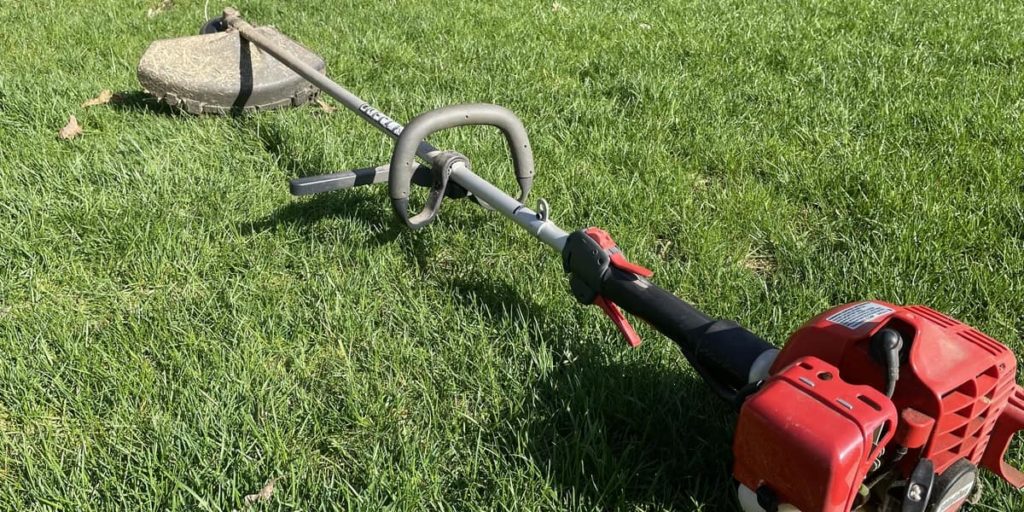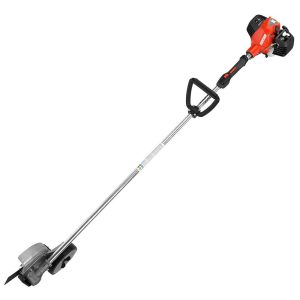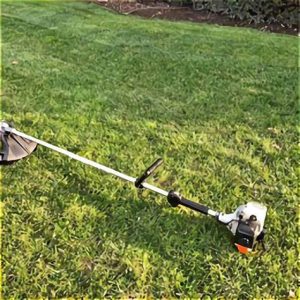How to Tune Up & Service Your Shindaiwa String Trimmer: Step-By-Step
Keeping your Shindaiwa string trimmer, weed eater, or weed wacker (whatever you choose to call it) in good condition is essential to keeping it running at its best and extending the life of your trimmer.
At least once a year, you should service your Shindaiwa string trimmer to check it for wear; replace missing and worn parts; remove debris and dirt from the cooling system; remove carbon buildup in the exhaust port and spark plug arrestor; replace maintenance components, and grease if necessary.
This should be done in addition to inspecting the trimmer for damage and wear before each use.
14 Steps to Service & Tune Up a Shindaiwa String Trimmer:
- Gather tools and supplies
- Remove the spark plug wire & follow safety precautions
- Replace old fuel
- Replace air filter
- Replace fuel filter
- Check the fuel system
- Replace the spark plug
- Clean the cooling system
- Clean the spark plug arrestor
- Clean the exhaust port
- Clean the exterior and trimmer head
- Tighten loose hardware & replace broken or missing parts
- Grease the shaft and gear housing (on select models)
- Reattach the spark plug wire

This post may include affiliate links. Purchases made through these links may provide a commission for us, at no extra cost to you. As an Amazon Associate, we earn from qualifying purchases.
Follow all safety instructions provided in your equipment operator’s manual prior to diagnosing, repairing, or operating.Consult a professional if you don’t have the skills, or knowledge or are not in the condition to perform the repair safely.
Table of Contents
Perform Maintenance on a Shindaiwa String Trimmer: Step-By-Step
Step 1: Gather Tools and Supplies for Shindaiwa String Trimmer Maintenance
- Socket set and screwdrivers
- Air filter
- Fuel filter
- Spark plug
- Clean rags
- Plastic or wood scraping tool
- Wire brush or small torch (optional)
- Bristle brush
- Safety gear: gloves, glasses
Step 2: Remove the Spark Plug Wire on Your Shindaiwa String Trimmer & Follow All Safety Precautions
Before performing maintenance on your Shindaiwa string trimmer, it’s important you understand and follow all safety procedure so you don’t get hurt. This includes removing the spark plug wire. Some refer to it as the spark plug boot.
Wait for the engine to cool and all moving parts to stop. Refer to your operator’s manual for additional safety precautions.
Step 3: Replace Old Fuel in a Shindaiwa String Trimmer
If the fuel in your string trimmer is older than 30 days, it’s best to replace it to prevent fuel system and engine problems that can develop from running old fuel.
Fuel that includes a fuel stabilizer must be replaced if the fuel is no longer stable. Check how long the fuel additive works to stabilize the fuel. Some additives will stabilize your fuel for up to 30 days while others work up to two years.
Running old gas through your Shindaiwa trimmer can cause varnish and sticky deposits to form that can clog the fuel system. Moisture can build up in the gas and prematurely corrodes your Shindaiwa.
To minimize the negative effects old fuel can have on your Shindaiwa, follow these tips:
- Always use fresh gasoline
- Only purchase enough gas that can be consumed within 30 days.
- If you purchase more fuel than you can consume quickly, add a fuel stabilizer to the fresh fuel to make it last a little longer.
- Store gasoline in an approved container in a dry location away from moisture.
- Mark the fuel can with the fuel-to-oil ratio mixture to avoid using the fuel in the wrong equipment.
Shindaiwa 2-cycle engine gas and oil mix.
A 2-cycle Shindaiwa string trimmer requires a gas and oil mixture at the rate of 50:1. 50 parts of unleaded gasoline with an ethanol content of less than 10% and an octane rating of 89 or higher must be mixed with 1 part of a premium 2-cycle engine oil.
ECHO PowerBlend, ECHO Red Armor, or another 2-cycle oil that is ISO-L-EGD and JASO M345 FD certified can be used. Read more about choosing the right fuel for your Shindaiwa in “This is the Type of Gas and Oil Shindaiwa String Trimmers Use“
Add a fuel stabilizer like Sea Foam or STA-BIL to the fuel to stabilize the fuel and reduce moisture in your Shindaiwa string trimmer if needed. Again, some 2-cycle oils include a long-lasting stabilizer while others do not.
Step 4: Replace the Air Filter on a Shindaiwa String Trimmer
When a Shindaiwa trimmer takes in the air the engine needs to run, it also draws dust and debris to the engine. In order to prevent dirt from entering the air intake and wearing on the engine, an air filter is used.
While the air filter is an essential maintenance part to help protect your engine, it can also become a problem and potentially hurt the engine when it becomes so dirty that the engine can’t get sufficient air.
The air filter should be changed annually and regularly checked and cleaned throughout the year. You may have to replace the air filter more often if you use your trimmer more than the average homeowner or if you are using it in very dusty conditions.
Replace a Shindaiwa air filter
- Remove the air filter cover. It may be held on with clips or a latch.
- Remove the dirty air filter.
- Wipe any dirt or debris out of the air filter housing and cover.
- Install a new air filter.
- Reattach the air filter cover.
Step 5: Replace the Fuel Filter in a Shindaiwa String Trimmer
Another area where dirt can get into the system and contaminate the engine is through the fuel system. A fuel filter is used to strain the fuel in the fuel tank before it enters the fuel pickup tube.
When the fuel filter becomes plugged, it can cause your Shindaiwa string trimmer to not start, run rough, and die after starting. The fuel filter should be replaced annually and more often if you find you are running a dirty tank of fuel.
- Wipe around the fuel cap to remove dirt.
- Remove the fuel cap.
- Pull the filter out of the fuel tank. A clean bent wire may help you pull it out of the tank
- Holding the fuel line and fuel filter, gently pull the filter out of the fuel line. Don’t allow the ring clip to come off of the fuel line.
- Install a new fuel filter into the fuel line with the ring clip over the fuel line and fuel filter male end to secure the fuel line to the filter.
- Place the fuel filter inside the fuel tank.
- Reattach the fuel cap.
Step 6: Check the Fuel System on a Shindaiwa String Trimmer
Inspect the fuel tank, fuel lines, and fuel cap. If you find leaks or cracks in the tank or fuel lines, they must be replaced before operating the string trimmer.
Make sure the fuel lines are securely attached so air isn’t sucked into the fuel system causing a loss of power.
Step 7: Replace the Spark Plug on a Shindaiwa String Trimmer
Remove the spark plug and replace it with a new spark plug that is gapped correctly. Don’t secure the spark plug wire until all work is completed on the string trimmer.
When the spark plug becomes worn, damaged, or dirty it can cause an intermittent spark problem that will affect your engine’s performance.
Don’t reconnect the spark plug wire until you are finished servicing your Shindaiwa string trimmer.
Step 8: Clean the Cooling System on a Shindaiwa String Trimmer
The engine can overheat and shut down when it gets hot due to debris and dirt clogging the air passageways. When the airways become plugged, the air is not able to circulate around the engine to keep it cool.
Confirm the spark plug is removed. Remove the engine cover and remove all debris from the cover and around the engine, including the cooling fins. Remove debris with a bristle brush (not made of metal).
Do not use a metal object to clean the unit as this can damage the string trimmer.
Step 9: Clean the Spark Plug Arrestor on a Shindaiwa String Trimmer
The spark arrestor is a small metal screen that prevents hot exhaust material from leaving the muffler and starting a fire. When this small screen becomes plugged you may experience a loss of power where your Shindaiwa string trimmer won’t run at full RPMs.
Confirm the spark plug wire is disconnected. Remove the engine cover and the engine exhaust cover. Carefully remove the spark arrestor screen. Clean it with a metal brush.
If the screen isn’t able to be sufficiently cleaned or you find it is damaged or has a hole in it, replace it with a new spark arrestor screen.
Step 10: Clean the Exhaust Port on a Shindaiwa String Trimmer
The exhaust port located behind the muffler can develop carbon deposits that can cause your Shindaiwa string trimmer running problem. When performing this task, be careful not to damage the catalytic element in the muffler.
Disconnect the spark plug wire and make sure the engine and muffler are cool so you don’t burn yourself.
Remove the engine cover, the muffler, and the heat shield. Adjust the piston until it covers the port opening. This will keep carbon from falling into the cylinder.
Use a plastic or wood scraper to remove the carbon buildup around the exhaust port. DO NOT use a metal tool. Do not scratch the piston or the cylinder during this process. Reinstall the items in the reverse order you removed them.
Step 11: Clean the Exterior of a Shindaiwa String Trimmer
Remove dirt and debris from the exterior of your string trimmer using a clean cloth. Use water with a mild dish soap to dampen the cloth to remove dirt from around the string trimmer head. Avoid harsh cleaners.
Step 12: Tighten Loose Hardware and Replace Missing or Damaged Parts on a Shindaiwa String Trimmer
Look over your string trimmer carefully to find any hardware that may have become loose or is now missing. Tighten the loose hardware.
Replace any missing or broken components on your trimmer. Make sure all safety guards and shields are in place. Don’t operate your Shindaiwa without these safety items in place.
Step 13: Grease the Shaft (Flex Cable Models) & Grease the Gear Housing on a Shindaiwa Trimmer
Apply lithium-based grease like Red Armor from ECHO to the gear housing if your model has a grease plug. If it does not, you don’t have to grease it.
If your model Shindaiwa uses a flex cable, remove the gear case and pull out the flex cable. Wipe it clean and apply a half ounce of lithium-based grease. Don’t get any dirt on the cable and reinstall it.
Step 14: Reattach Spark Plug Wire on Your Shindaiwa String Trimmer
Once all services are performed on your Shindaiwa string trimmer, reattach the spark plug to use the trimmer.







